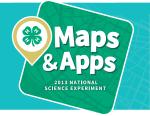COLUMBIA, Mo. –Although it once brought to mind thoughts of cow, sows, plows and pillow-making, 4-H today is just as likely to involve studying maps, apps, robotics and aeronautics.
Oct. 9 is 4-H National Youth Science Day, and Missouri 4-H’ers are at the forefront of learning about science, technology, engineering and math (STEM), says University of Missouri Extension geospatial specialist Shannon White.
Currently, 5 million young people across the nation take part in 4-H STEM programming such as robotics, agricultural science, rocketry, wind power, environmental science, geographic information systems and biofuels.
Missouri 4-H’ers are enrolling in STEM projects in record numbers. Six years ago, 200 members participated in the robotics program. Today there are almost almost 1,000 participants from 84 counties, plus 209 volunteers.
This year’s Youth Science Day is focused on “Maps & Apps,” a response to the development of sophisticated spatial technologies, including geographic information systems (GIS) and global positioning systems (GPS), subjects near and dear to White’s heart.
She coordinates the Missouri Geographic Alliance, an educational outreach entity that is part of the National Geographic Alliance Network. She is in charge of Summers @ Mizzou’s GeoTech Camp and works with local, regional, state and federal entities to promote, understand and research geospatial applications.
White said 4-H’ers are excited to learn skills leading to careers in high-demand areas. The U.S. Department of Labor ranks GIS/GPS among the fastest-growing occupational fields in the nation, she said. The market is growing at an annual rate of almost 35 percent, with the commercial subsection of the market expanding by 100 percent each year.
This year’s National Science Experiment offers a set of activities that turns young people into geospatial thinkers as they design and map their ideal park, using GIS mapping to solve community problems and contribute data about their community to the U.S. Geological Survey. The project appeals to both urban and rural 4-H members, White said.
For more than 10 years, 4-H’ers been applying GIS/GPS technologies within their communities. In Missouri, White worked with Summers @ Mizzou’s GeoTech Camp members to collect data for the City of Columbia’s sidewalk program.
White said STEM projects support a study by Richard Lerner at the Institute for Applied Research in Youth Development at Tufts University. That study shows that young people involved in 4-H do better academically and are more likely to go to college than peers who aren’t in 4-H. They are twice as likely to participate in STEM learning programs.
For more information about 4-H National Youth Science Day, visit www.4-H.org/NYSD. To learn more about Missouri 4-H, go to 4h.missouri.edu.
Read more http://extension.missouri.edu/news/DisplayStory.aspx?N=2010





